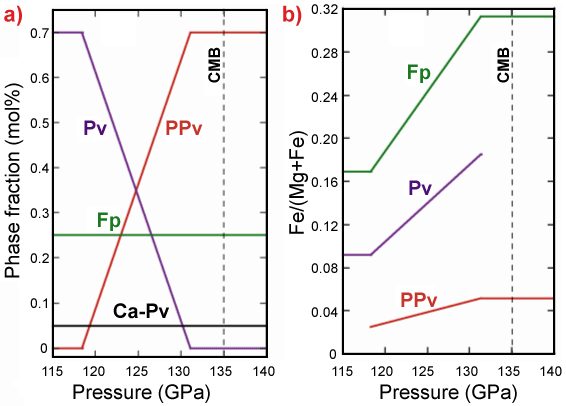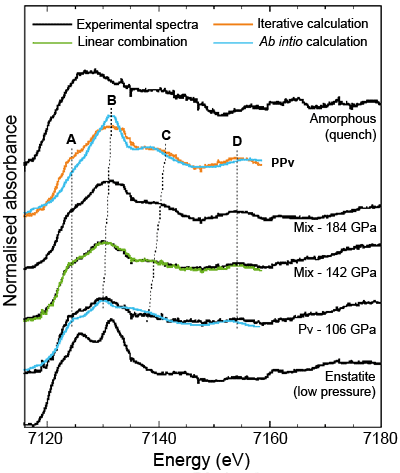- Home
- News
- Spotlight on Science
- The deepest phase...
The deepest phase transition in the Earth's mantle
16-06-2010
The Earth’s mantle is layered because of successive phase transitions occurring with increasing pressure and temperature. These transitions are understood by comparison between the seismic reflectors and experimentally determined phase diagrams. Nonetheless, peculiar seismic features observed in the D"-layer remain difficult to interpret. Here, a phase transition occurs which transforms the structure of the silicate mineral from its lower pressure stable form, the perovskite phase, to a different structure called post-perovskite. The study of this phase transition, which occurs at ~110 GPa, could help explain some of these anomalies. However, while the transition is well characterised for a simplistic MgSiO3 composition, its mechanisms remain ambiguous for the Earth’s real composition. In particular Al and Fe are known to modify significantly the phase diagram and elastic properties of the mantle minerals. By means of Fe K-edge XANES and X-ray diffraction measurements, scientists investigated the fraction of coexisting perovskite and post-perovskite phases, together with the Fe distribution in a pressure domain extending from 100 to 185 GPa. Their results give evidence for the coexistence of the two silicate phases throughout the whole D"-layer, with a post-perovskite phase depleted in Fe. The phase diagram is incompatible with any sharp seismic reflector in this mantle region.
Share
The D"-layer is a 100-300 km thick layer lying just above the core-mantle boundary at 2900 km below the surface of the earth, under a pressure of ~100 to 135 GPa. In this region, seismic observations provide evidence of heterogeneities in wave propagation and sound velocities. Since the perovskite (Pv) to post-perovskite (PPv) phase transition was discovered for MgSiO3 [1], various authors attempted to explain all peculiar seismic features on the basis of this transformation. Indeed, the local structure is quite different in these two phases; the PPv is layered (Figure 1), which enhances significantly its elastic anisotropy, and could help to explain the seismic heterogeneities [2,3]. However, these heterogeneities are observed within the D"-layer and at some restricted geographic positions only. This contrasts with the sharp seismic discontinuities observed all over the globe at different mantle depths, such as the transition-zone extending from depths of 410 to 660 km. Thus, based on MgSiO3 studies, the post-perovskite transformation is unlikely to be the only source of the seismic anomalies in the D" region and other hypotheses remain plausible, such as the presence of a primitive and chemically different mantle reservoir, the presence of a cemetery of oceanic plates subducted by mantle convection, or the occurrence of partial melting at the core-mantle boundary (CMB).
 |
|
Figure 1. The post-perovskite structure, analagous to CaIrO3, shows an anisotropic compression behaviour with b axis more compressible than the others [1, 2]. |
Most of the previous experimental investigations of the Pv to PPv transition mechanism suffer from the limitation that the MgSiO3 composition is too simple. When more relevant mantle compositions were investigated, the chemical analyses were only performed ex situ on samples recovered at ambient conditions. In this work, we investigated in situ at high P and T the mineralogical content and the Fe distribution in various geological samples, using tandem analyses of X-ray absorption spectroscopy at the Fe K-edge (ID24) and X-ray diffraction (ID27). Thanks to these techniques, phase relations between the minerals could be determined for bulk samples, in opposition to the thin films that were analysed in previous studies. Pressures up to 180 GPa were obtained using diamond-anvil cells, exceeding the pressure of 135 GPa found at the CMB. YAG laser heating was used to reach temperatures of more than 3000 K.
Synthesis of the Pv and PPv grains was carefully monitored using X-ray diffraction, for variable heating duration and temperatures. The sharpness of the Bragg lines and occurrence of a multitude of small spots on the 2-dimensional X-ray pattern indicate efficient atomic diffusion at the scale of the grain size and quasi-equilibrium crystallisation of the silicate phases. The diffraction patterns reveal the presence of two crystalline phases, the Pv and PPv, up to the maximum pressure investigated. Relative proportions of the different minerals were quantified based on Rietveld refinements. We then performed Fe K-edge XANES on the same samples in order to retrieve the Fe coordination site and thus the preferential Fe insertion in Pv or PPv phases (Figure 2). Combined with PPv fractions determined using X-ray diffraction, we calculated the Fe-partition coefficient between the two phases.
Our results show that the main PPv phase is largely depleted in Fe, compared to the Pv phase. Also, we report the proportion and composition of each mineral in the P-T conditions of the D"-region (Figure 3). These results have severe geophysical consequences. First, we show that Fe and Al produce a progressive phase transition from Pv to PPv, in contrast with pure MgSiO3. This transition mechanism is incompatible with the presence of any sharp seismic reflectors in the D"-layer. More progressive seismic anomalies should be expected, which is compatible with the seismic observations in this mantle region. Then, the occurrence of a PPv-phase with a minimum Fe-content has two major implications: (i) it should enhance the radiative thermal conductivity in the D"-layer, since Fe-free minerals are generally transparent to visible light. This can induce a much higher temperature in the lowermost mantle that is in contact with the outer core; (ii) The FeO activity in the mantle is much enhanced at the CMB, as evidenced by a FeO content up to ~0.30 mole percent in ferropericlase (See Figure 3). Thus, FeO should diffuse to the outer core, with a concomitant loss of FeO in the lowermost mantle. This can affect the density of the material located in the D"-layer and can induce unstable dynamical behaviour in this region.
 |
|
Figure 3. a) Fractions of lower mantle minerals and b) Fe concentration in minerals plotted as a function of pressure for the four phases expected in the lowermost mantle region. Pv, PPv, Fp and Ca-Pv stand for Al-bearing (Mg,Fe)SiO3 perovskite and post-perovskite phases, (Mg,Fe)O ferropericlase and CaSiO3 perovskite, respectively. The Earth's core-mantle boundary is located at 135 GPa. |
References
[1] M. Murakami, K. Hirose, K. Kawamura, N. Sata, Y. Ohishi, Science 304, 855 (2004).
[2] N. Guignot, D. Andrault, G. Morard, M. Mezouar, Earth and Planetary Science Letters 256, 162 (2007).
[3] K. Hirose, Y. Fei, P. Ma, H.K. Mao, Nature 397, 53 (1999).
[4] Derived from L.H. Kellogg, B.H. Hager, R.D. van der Hilst, Science 283, 1881-1884 (1999).
Principal publication and authors
D. Andrault (a), M. Muñoz (b), N. Bolfan-Casanova (a), N. Guignot (c), J.P. Perrillat (d), G. Aquilanti (d), S. Pascarelli (d), Earth and Planetary Science Letters 293, 90-96 (2010).
(a) LMV, Université Blaise Pascal, Clermont-Ferrand (France)
(b) LGCA, Université Joseph Fourier, Grenoble (France)
(c) SOLEIL, Gif-sur-Yvette (France)
(d) ESRF
Top image: Experiments at extreme conditions provide insight into the composition of the D''-layer just above the core-mantle boundary at 2900 km below the surface of the Earth [4].




